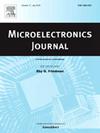String-level compact modeling of erase operations in the body-floated vertical channel of 3D charge trapping flash memory
IF 1.9
3区 工程技术
Q3 ENGINEERING, ELECTRICAL & ELECTRONIC
引用次数: 0
Abstract
In this study, we examined the use of string-level compact modeling as an effective framework for circuit simulation focusing on erase operation in 3D charge trapping flash (CTF) memory devices. We analyzed the behaviors of the accumulated hole from p-type bulk (p-well) and the corresponding difference of channel electrostatic potential in the CTF cell string, which is attributed to the variation in hole barrier height in the channel of the ground select line (GSL) transistor during erase operation. We derived a formula for the hole current delivering positive potential from the p-well to the channel region and established a modeling procedure. Technology computer-aided design (TCAD) simulation results were used to extract model parameters and analyze channel electrostatic potential during the erase operation. Additionally, experimental data for erase speed were verified using simulation program with integrated circuit emphasis (SPICE) results. Because the erase efficiency is strongly related to hole behaviors based on the conditions of the GSL transistor, the proposed compact modeling is an effective tool for circuit designers and system architects to achieve better performance in erase execution and optimizing the design of 3D CTF memory devices.
三维电荷陷阱闪存体浮垂直通道中擦除操作的字符串级紧凑建模
在本研究中,我们将串级紧凑建模作为电路仿真的有效框架,重点研究了三维电荷捕获闪存(CTF)器件中的擦除操作。我们分析了在擦除操作过程中来自 p 型体(p-well)的累积空穴的行为以及 CTF 单元串中相应的沟道静电电势差,这种静电电势差归因于接地选择线(GSL)晶体管沟道中空穴势垒高度的变化。我们推导出了从 p-阱向沟道区传递正电势的空穴电流公式,并建立了建模程序。技术计算机辅助设计 (TCAD) 仿真结果用于提取模型参数和分析擦除操作过程中的沟道静电电势。此外,擦除速度的实验数据还通过集成电路仿真程序(SPICE)的结果进行了验证。由于擦除效率与基于 GSL 晶体管条件的空穴行为密切相关,因此所提出的紧凑建模是电路设计人员和系统架构师在擦除执行和优化 3D CTF 存储器件设计中实现更佳性能的有效工具。
本文章由计算机程序翻译,如有差异,请以英文原文为准。
求助全文
约1分钟内获得全文
求助全文
来源期刊

Microelectronics Journal
工程技术-工程:电子与电气
CiteScore
4.00
自引率
27.30%
发文量
222
审稿时长
43 days
期刊介绍:
Published since 1969, the Microelectronics Journal is an international forum for the dissemination of research and applications of microelectronic systems, circuits, and emerging technologies. Papers published in the Microelectronics Journal have undergone peer review to ensure originality, relevance, and timeliness. The journal thus provides a worldwide, regular, and comprehensive update on microelectronic circuits and systems.
The Microelectronics Journal invites papers describing significant research and applications in all of the areas listed below. Comprehensive review/survey papers covering recent developments will also be considered. The Microelectronics Journal covers circuits and systems. This topic includes but is not limited to: Analog, digital, mixed, and RF circuits and related design methodologies; Logic, architectural, and system level synthesis; Testing, design for testability, built-in self-test; Area, power, and thermal analysis and design; Mixed-domain simulation and design; Embedded systems; Non-von Neumann computing and related technologies and circuits; Design and test of high complexity systems integration; SoC, NoC, SIP, and NIP design and test; 3-D integration design and analysis; Emerging device technologies and circuits, such as FinFETs, SETs, spintronics, SFQ, MTJ, etc.
Application aspects such as signal and image processing including circuits for cryptography, sensors, and actuators including sensor networks, reliability and quality issues, and economic models are also welcome.
 求助内容:
求助内容: 应助结果提醒方式:
应助结果提醒方式:


